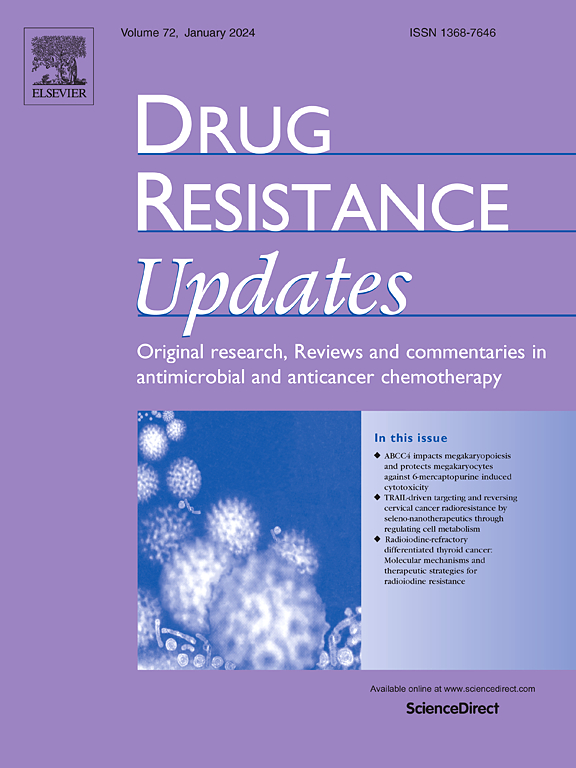KpnK48 clone driving hypervirulent carbapenem-resistant Escherichia coli epidemics: Insights into its evolutionary trajectory similar to Klebsiella pneumoniae
IF 15.8
1区 医学
Q1 PHARMACOLOGY & PHARMACY
引用次数: 0
Abstract
Aims
Hypervirulent and carbapenem-resistant pathogens posed a significant and growing threat to global public health. This study focused on the rapid spread of a hypervirulent carbapenem-resistant E. coli (hv-CREC) subclone and its genomic resembles with hypervirulent carbapenem-resistant K. pneumoniae (hv-CRKP), driven by recombination impacting both chromosomal and plasmid gene content.
Methods
A multicenter molecular epidemiological study was conducted on 653 CREC clinical isolates collected across China (2013–2022), integrated with public genomic data. Pangenome-wide and phylogeographical analyses were performed to uncover recombination events, define the epidemic clone, and trace its evolutionary history. Growth advantage and virulence were evaluated through competition assays and Galleria mellonella infection models.
Results
Sequence types (ST) 167, ST410, ST617, and ST361 collectively accounted for 53.8 % (351/653) of the CREC isolates, with ST167 showing a sharp increase in prevalence after 2017. Among these, subclone named KpnK48 emerged as the primary driver of the increase in ST167 CREC prevalence. Traced to a European origin, KpnK48 rapidly expanded globally, particularly in China. The remarkable success of KpnK48 could plausibly be attributed to enhanced survival and virulence, driven by the acquisition of a ∼492 kb recombinant genomic region which mirrored the genomic architecture underlying the hv-CRKP ST11-K64 clone, reflecting a Klebsiella-like evolutionary path. Additionally, plasmid shift in KpnK48 clone from the prevalent NDM-IncX3 plasmid to Klebsiella-common NDM-IncF plasmid expanded its resistance spectrum and virulence gene repertoire, likely further amplifying its pathogenicity and success.
Conclusions
The KpnK48 subclone combined the features of hypervirulence and carbapenem resistance, bridging genomic traits of E. coli and K. pneumoniae, signifying a broader evolutionary trend with profound global health implications.
KpnK48克隆驱动高毒性耐碳青霉烯类大肠杆菌流行:与肺炎克雷伯菌相似的进化轨迹
高毒力和碳青霉烯耐药病原体对全球公共卫生构成了重大且日益严重的威胁。本研究的重点是高毒力耐碳青霉烯大肠杆菌(hv-CREC)亚克隆的快速传播及其基因组相似性与高毒力耐碳青霉烯肺炎克雷伯菌(hv-CRKP),由影响染色体和质粒基因含量的重组驱动。方法采用多中心分子流行病学方法对2013-2022年全国653株临床分离株进行分析,并结合公开基因组数据。进行全基因组和系统地理分析,以揭示重组事件,确定流行病克隆,并追踪其进化史。通过竞争试验和mellonella感染模型评价生长优势和毒力。结果序列型(ST) 167、ST410、ST617和ST361共占CREC分离株的53.8 %(351/653),其中ST167型在2017年后发病率急剧上升。其中,名为KpnK48的亚克隆成为ST167 CREC患病率增加的主要驱动因素。KpnK48起源于欧洲,在全球迅速扩张,尤其是在中国。KpnK48的显著成功可能是由于获得了一个约492 kb的重组基因组区域,这反映了hv-CRKP ST11-K64克隆的基因组结构,反映了克雷伯氏菌样的进化路径,从而提高了存活率和毒力。此外,KpnK48克隆的质粒从流行的NDM-IncX3质粒转移到克雷伯菌常见的NDM-IncF质粒,扩大了其抗性谱和毒力基因库,可能进一步增强了其致病性和成功性。结论KpnK48亚克隆结合了高毒力和碳青霉烯类耐药的特点,架起了大肠杆菌和肺炎克雷伯菌的基因组特征,标志着一种更广泛的进化趋势,具有深远的全球健康意义。
本文章由计算机程序翻译,如有差异,请以英文原文为准。
求助全文
约1分钟内获得全文
求助全文
来源期刊

Drug Resistance Updates
医学-药学
CiteScore
26.20
自引率
11.90%
发文量
32
审稿时长
29 days
期刊介绍:
Drug Resistance Updates serves as a platform for publishing original research, commentary, and expert reviews on significant advancements in drug resistance related to infectious diseases and cancer. It encompasses diverse disciplines such as molecular biology, biochemistry, cell biology, pharmacology, microbiology, preclinical therapeutics, oncology, and clinical medicine. The journal addresses both basic research and clinical aspects of drug resistance, providing insights into novel drugs and strategies to overcome resistance. Original research articles are welcomed, and review articles are authored by leaders in the field by invitation.
Articles are written by leaders in the field, in response to an invitation from the Editors, and are peer-reviewed prior to publication. Articles are clear, readable, and up-to-date, suitable for a multidisciplinary readership and include schematic diagrams and other illustrations conveying the major points of the article. The goal is to highlight recent areas of growth and put them in perspective.
*Expert reviews in clinical and basic drug resistance research in oncology and infectious disease
*Describes emerging technologies and therapies, particularly those that overcome drug resistance
*Emphasises common themes in microbial and cancer research
 求助内容:
求助内容: 应助结果提醒方式:
应助结果提醒方式:


